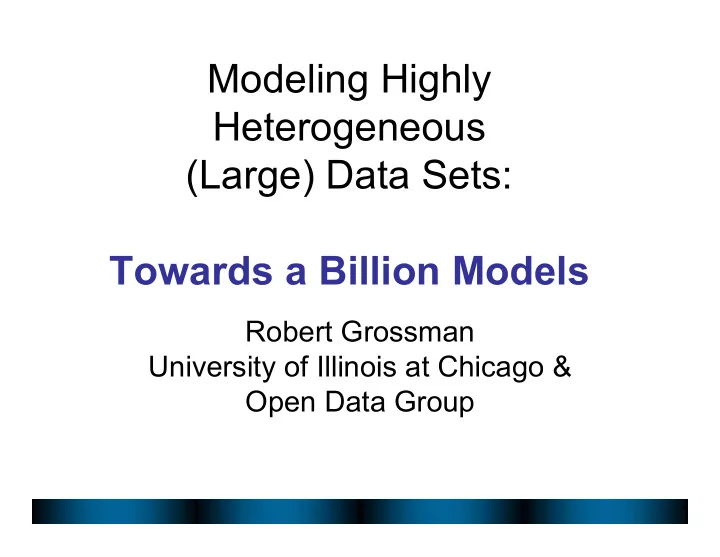

Modeling Highly Heterogeneous (Large) Data Sets: Towards a Billion Models Robert Grossman University of Illinois at Chicago & Open Data Group
Traditional Statistics One small data set A few attributes Vector-valued data Data Mining Few large data sets Many attributes Complex data
But Large Data Is Not Homogeneous Statistics Large Large, Highly Data Heterogeneous Today Data (Tomorrow) Data Small Large Large Attributes Few Many Many Structure Vector Complex Complex Populations One Several Many
Features vs. Model Our interest: one billion Parameters models … Feature Model Vector vs … Model Parameters Parameters … Feature Vectors Feature Vector … Model Today, we can Parameters manage one billion feature vectors.
Progress to Date Machine Highly Manually segmented Single segmented hetero- model, Ensembles of models models geneous models (homogeneous) models ? 1 10 100 1000 10E4 10E5 10E6 10E9
Example 1 - 42,000 Models Is the traffic speed and volume today (Tuesday, May 15, 4:30 pm,, no rain) different than the baseline model? Separate model for 7 days x 24 hours x 250 locations = 42,000 models • 833 road sensors Anomalies • weather data (images, xml) • text data about special events
GLR Change Detection Algorithms (Single Model) Baseline Observed Model Model β Sequence of events x[1], x[2], x[3], … Question: is the observed distribution different than the baseline distribution? Use simple CUSUM & Generalized Likelihood Ratio (GLR) tests ... but use thousands of them
Build 10 4 + Models Geospatial region Build segmented 1. models using multidimensional data cubes For each distinct Day x 2. cube, estimate Hour Types of parameters for weather separate statistical model Modeling using Cubes Detect changes from 3. of Models (MCM)- separate baselines and send baselines for each cell alerts in real time
Greedy Meaningful/Manageable Balancing (GMMB) Algorithm Breakpoint • More alerts • Fewer alerts • Alerts more • Alerts more meaningful manageable • To increase alerts, •To decrease alerts, add breakpoint remove breakpoint, One model for each to split cubes, order by number cell in data cube order by number of decreased alerts, of new alerts, & & select one or more select one or more breakpoints to remove new breakpoints
Example 2: Data Quality for Payment Systems Account Issuing Bank Merchant Merchant Bank • 6000+ peak transactions per second.
Payments Data is Highly Heterogeneous Variation merchant to • merchant Variation bank to bank • Daily variation • Variation season to • season
Data Cubes of Models - Payments Systems Build separate model for each • 20,000+ separate bank (c. 1000) baselines Geospatial Build separate model for each • region geographical region (6 regions) Build separate model for each • different type of merchant (c. 800 types of merchants) Type of For each distinct cube, • Transaction establish separate baselines Entity (bank, for each metric of interest etc.) (declines, etc.) Modeling using Cubes Detect changes from baselines • of Models (MCM)
Example 3 - Emergent Behavior Network Packet Data Data collected in real time from several different distributed sensors (Angle) Still investigating best dimensions for cube Build separate cluster model for each cell in cube
Angle Scoring Functions for Each Cube in Data Cube of Models • Hard scoring - use Update features using new max / min packets and evolve features s ( x ) = max k � B s k ( x ) Divide clusters into good (B or Blue), neutral, and bad (R • Soft scoring use sum or Red) � s ( x ) = s k ( x ) Blue - score using good k � B � R clusters • Scoring function for single cluster Red - score using bad � � 2 clusters exp � � x � µ k 1 � � s k ( x ) = � k � 2 � 2 � k � k Purple - score using both � � good and bad clusters � = 1 � k k
The Challenge This methodology can work quite well in practice. Develop some of the theory to guide this methodology and improve the methodology.
Other Applications George Church’s challenge individual predictive models for each human genome 6.5 Billion humans x 6 Billion Base Pairs Consumer Marketing - large advertisers will see 1-3 Billion different consumers Network defense / cyberdefense - 4 billion IPv4 addresses; billions of users; billions+ of IPv6 addresses
What About the Data? Highway change detection data is available highway.ncdm.uic.edu Angle network anomalies will be available What About the Software? Augustus - Will be available from Source Forge
References Robert L. Grossman, Michal Sabala, Javid Alimohideen, Anushka Aanand, John Chaves, John Dillenburg, Steve Eick, Jason Leigh, Peter Nelson, Mike Papka, Doug Rorem, Rick Stevens, Steve Vejcik, Leland Wilkinson, and Pei Zhang, Real Time Change Detection and Alerts from Highway Traffic Data, ACM/IEEE International Conference for High Performance Computing and Communications (SC '05). Joseph Bugajski, Robert L. Grossman, Eric Sumner and Steve Vejcik, Monitoring Data Quality for Very High Volume Transaction Systems, Proceedings of the 11th International Conference on Information Quality, 2006. Joseph Bugajski, Chris Curry, Robert L. Grossman, David Locke, Steve Vejcik, Detecting Changes in Large Data Sets of Payment Card Data: A Case Study, Proceedings of The Thirteenth ACM SIGKDD International Conference on Knowledge Discovery and Data Mining, ACM, 2007.
Recommend
More recommend